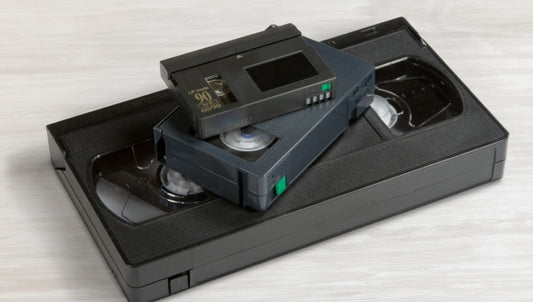DVDs were the most popular method for home videos for over a decade and still remain fairly popular despite being largely replaced by digital downloads and streaming platforms. Not only that, but some rare DVDs and special editions remain popular among collectors and enthusiasts, but do you know when and how the DVD format began?
Capture can turn your VHS tapes, photos, and analog film into digital DVD copies, but we also think it’s important to understand the history of different formats and the way they shape and store our most precious memories. That’s why we put together this article to thoroughly answer the question, “When did DVDs come out?”
Keep reading to learn about the historical timeline of DVDs including the technological background, release date, features, and cultural impact.
Table of Contents
- What came before DVD?
- Why Was DVD Created?
- What Is a DVD and What Does DVD Stand For?
- When Was the First DVD Released?
- What was the first movie released on DVD?
- DVD Timeline: Key Milestones
- DVD Features and Advancements
- DVD Region Codes and Compatibility
- Cultural and Historical Significance of DVDs
- Frequently Asked Questions About DVDs
- Looking Back on the Legacy of DVDs
What came before DVD?
Before DVDs, formats like VHS tapes and Sony Betamax shaped the way we watched movies at home. These analog formats stored content on magnetic tape, played back using a vintage VCR.
Introduced by JVC in 1976, VHS quickly became the dominant home entertainment format through the 80s and early 90s. But even then, companies were exploring optical disc options like Laserdisc, developed by MCA DiscoVision in 1978. Although it offered better video and audio quality than VHS and Betamax, it ultimately didn’t gain widespread adoption.
Hybrid technologies such as Hi8 tape players and Laserdisc bridged the gap between analog and digital, laying the groundwork for DVDs.

Why Was DVD Created?
The technologies behind DVD development began with the Laserdisc, introduced by MCA and Philips. While Laserdisc offered higher quality than VHS, it was large, expensive, and not fully digital. But it paved the way for future formats like the Compact Disc (CD), DVD, and later, Blu-Ray. The goal was to create a format that improved video and audio quality while increasing storage capacity.
The first of these new formats was the audio CD, which led to CD-ROMs capable of storing video games, photos, and multimedia. Some formats, like the Multimedia Compact Disc (MMCD) and Super Density Discs, attempted to store full-length movies, but they fell short. A CD vs DVD comparison highlights the issue: CDs held about 700 MB, while DVDs could store 4.7 to 17 GB, depending on the format. That simply wasn’t enough for your favorite Disney movies or '80s horror flicks.
Because of these limitations, companies kept refining disc technology. Toshiba and Time Warner led the development of DVD.

What Is a DVD and What Does DVD Stand For?
A DVD (Digital Versatile Disc) is an optical disc format used to store video, audio, and data. DVDs became the industry standard for home entertainment in the late 1990s, offering significantly better quality and storage capacity than VHS tapes.
Originally, DVD stood for Digital Video Disc. However, major tech players like Apple and Microsoft pushed back, arguing that the format had broader potential—like storing data, organizing old photos, playing video games, and more.
The name was eventually updated to Digital Versatile Disc, reflecting these expanded uses. With these innovations in place, DVDs and DVD players were soon ready to enter the home entertainment market—offering a compact, high-capacity solution that would quickly replace older analog formats.
When Was the First DVD Released?
In September 1996, the first Digital Video Disc (DVD) technology was finalized and released in Japan on November 1, 1996. The official DVD release date in the United States was March 24, 1997.
Early DVDs had a 1.46 GB single-layer capacity, but their improved quality quickly attracted attention.
What was the first movie released on DVD?
The first movie to be commercially released on DVD format in the United States was “Twister.” However, titles like “Blade Runner” and “The Fugitive” were released with the first DVD players in Japan before DVDs hit the domestic U.S. market.
At the early origin of DVDs, the format was still more expensive than VHS. It was clear that people preferred the discs because VHS tapes don’t last forever and DVDs offer better picture resolution, higher audio quality, larger capacity, and more compact size. Still, the higher cost would slightly delay the impact the DVD introduction to the market would have on home entertainment.
DVD Timeline: Key Milestones
| Year | Milestone |
|---|---|
| 1996 | DVD format finalized and launched in Japan |
| 1997 | First DVD players and movies (e.g., "Twister") released in the U.S. |
| 2000 | DVD players drop below $200, sales surge |
| 2003 | DVD rentals surpass VHS for the first time |
| 2006 | Major studios stop releasing new movies on VHS |
| 2008 | Blu-ray outsells HD-DVD; marks start of decline for standard DVD |
DVD Features and Advancements
The original DVD format brought major improvements to home media. Early DVDs offered:
- 4.7 GB storage capacity – enough for over two hours of high-quality video
- 720 x 480-pixel resolution – sharper than VHS
- Chapter skipping – allowed viewers to jump scenes without rewinding
- Multimedia file storage – supported video, audio, subtitles, and menus
As DVD technology evolved, several key advancements followed:
-
Dual-layer DVDs: Increased capacity to 8.5 GB on a single side
- Double-sided DVDs: Allowed for content on both sides of the disc
- Interactive menus: Enabled access to bonus features, alternate endings, and even games
- Writable formats (DVD-R, DVD-RW): Let users record home videos and back up data
- HD-DVD and Blu-ray: Built upon DVD with sharper resolution and higher capacity
These innovations made DVDs a favorite format for families and collectors. New releases began to include blooper reels, extended editions, and special features—something never possible with analog formats unless you used a VHS to digital converter.
Writable DVDs like DVD-R and DVD-RW also gave users the power to transfer VHS movies to blank DVDs at home—provided they had the right setup.
Today, you can even convert DVD to digital to make playback easier across all devices and preserve your library in the cloud.

DVD Region Codes and Compatibility
DVDs are not universally compatible across all players due to a system of region codes. These digital restrictions were created by movie studios to control release dates, pricing, and distribution across global markets.
What Are DVD Region Codes?
Each DVD is assigned a region number that corresponds to specific parts of the world:
- Region 1: United States and Canada
- Region 2: Europe, Japan, South Africa, and the Middle East
- Region 3: Southeast Asia, South Korea, Taiwan
- Region 4: Australia, New Zealand, Latin America
- Region 5: Russia, India, Africa (excluding South Africa)
- Region 6: China
- Region 0 or ALL: Region-free — can be played worldwide
Why Region Codes Matter
A DVD purchased in one region may not play on a player from another region unless the device is region-free or multi-region. This caused confusion for travelers and collectors alike, especially during the early 2000s.
Can You Bypass Region Restrictions?
Some modern DVD players and computer drives allow for region-free playback. Others may require firmware changes or software to override the lock—but this isn’t always recommended.
Cultural and Historical Significance of DVDs
The invention of the DVD was just the beginning. DVDs didn’t just replace VHS in 2002—they redefined how we watched movies at home and helped drive a major shift toward digital media.
You may be wondering: why were DVDs so popular? The answer lies in the combination of quality, convenience, and experience. With DVDs, you could skip scenes, explore bonus features, and enjoy sharper video and audio—all in a compact, durable disc. Compared to worn-out VHS tapes, DVDs felt like the future.
Even computers embraced the format, adding DVD drives that let users watch movies, burn files, and back up personal data. As we moved from analog to digital, DVDs were part of a bigger shift: from photo prints to digital photo storage, from cassette tapes to CDs, and from offline to online life.

DVDs also became collectibles. People built personal libraries, hunted down special editions, and proudly displayed boxed sets of their favorite movies. The highest-selling DVD of all time, “Finding Nemo,” sold over 38 million copies, while many other discs hold value today for their rarity or packaging.
But DVDs couldn't hold back the tide of streaming. Services like Netflix—ironically, once a DVD-by-mail company—ushered in the age of instant, on-demand access. DVDs gradually disappeared from store shelves as convenience won out over physical ownership.
Even so, DVDs are far from forgotten. Whether kept for nostalgia, collectibility, or playback in offline areas, they still matter. And for those who want to protect collections of personal home movies, you can always convert DVD to digital and keep your favorites forever.
Just like Super 8 film and VHS before them, DVDs mark a defining moment in how we captured, shared, and enjoyed our stories.
Digitize Your Home Movie DVDs
Keep your family memories safe by converting old home movie DVDs to digital with Capture.
Digitize Home DVDsFrequently Asked Questions About DVDs
When did DVDs come out?
DVDs were first released in Japan on November 1, 1996, and in the United States on March 24, 1997. These early discs had 1.46 GB of storage and marked a major leap forward from VHS.
What was the first DVD ever released?
The first DVD commercially released in the U.S. was "Twister" in 1997. In Japan, early DVD player bundles included films like Blade Runner and The Fugitive.
When did DVDs replace VHS?
DVDs surpassed VHS rentals for the first time in 2003. By 2006, major movie studios had stopped releasing films on VHS altogether.
Why were DVDs so popular?
DVDs offered improved picture and sound, compact design, chapter skipping, and bonus features—making them more versatile and enjoyable than VHS tapes.
What does DVD stand for?
DVD originally meant Digital Video Disc, but was later renamed Digital Versatile Disc to reflect its use for data, games, photos, and video.
Are DVDs still being made?
Yes, although in smaller volumes. DVDs are still produced for collectors, offline use, and special releases, even as streaming dominates the market.
Can I convert DVD to digital?
Yes. Services like Capture can convert your DVDs into digital formats for long-term storage and easy access across devices.
What are DVD region codes?
DVD region codes are digital locks that restrict where a DVD can be played. A Region 1 DVD (U.S. and Canada) typically won’t work in a Region 2 player (Europe, Japan, etc.) unless it’s region-free.

Looking Back on the Legacy of DVDs
Now that you know the answer to “When did DVDs come out?” as well as the entire history of DVD, you can look back on those years, rewatch your favorite DVD movies, and reminisce about the format that shaped our lives for nearly two decades. From the introduction in 1996 and 1997 to dual-layer DVDs, major releases, and storage of photos, home movies, and more, most families still have DVDs lying around.
If you are one of those families with DVDs or even old VHS tapes lying around, Capture can help you upgrade to cloud storage and preserve your home movies and family photos forever.











